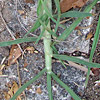Kikuyu grass is a perennial yellowish-green grass, stoloniferous and rhizomatous often turf forming. It is native to the highlands of East Africa but is now common in many areas of the world as a result of its introduction as turf and fodder grass to other parts of Africa, Europe, America, Australia, and Asia.
Kikuyu grass spreads by numerous large, fleshy, creeping stolons and rhizomes that sometimes reach 2 m or more in length and depth, its stolons root readily at each node, producing stout leafy branches 60 cm in length; thus it is considered an excellent colonizer and soil stabilizer.
The leaves are a few mm wide and their length is determined largely by its management. In frequently mowed lawns they are only 3-5 cm long, but in uncut stand they can reach 20 cm. In such uncut stands the stolons tend to grow uptight.
The species scientific name means “hidden” and refers to the flowers. The spikes are very small and contain only three small spikelets. In the common varieties the filaments of the anthers are 2-3 cm long and have bright white color. They are clearly evident above the leaves in freshly cut lawns during the spring and summer months, but there are known varieties in which the development of the anthers is arrested and they are functionally female plants.
Kikuyu seeds germinate readily and help spreading of the plants that can rapidly become invasive. In the Israeli climate, however, it requires irrigation to sustain it through the summer.
Kikuyu grass is a hardy plant that can withstand a wide range of climate and soil conditions including mild salinity and extreme pH. It has been used as a pasture plant, due to its high growth rate and well-developed root system, and to its high nutritive properties; kikuyu is a highly digestible, high-protein, low fibre and palatable grass.
Pennisetum clandestinum was described in 1903. It was given the name “Kikuyu grass” since it was collected in 1911 on the shores of Lake Naivasha, which was then in the tribal land of the Kikuyu, which is the largest ethnic group in Kenya. It was introduced into other parts of East and South Africa as a pasture grass and from there to the rest of the world. Its invasive nature was first noted in California and later in Australia and New-Zealand, as well as other subtropical regions of the world.
The pollen of kikuyu grass is allergenic and causes allergies during the spring and summer months. In this respect using the male-sterile varieties has a clear advantage.
Written By Amram Eshel






